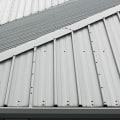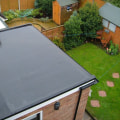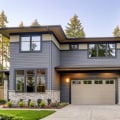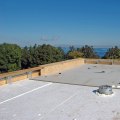Gable roofs are the most popular type of roof in the United States. With two sloped sides and a triangular shape, they are the simplest roof to construct and one of the most sought-after. Gable roofs can be adapted to all types of architectural styles, but they may cost more than typical roofs due to the ornaments and details they contain. However, the additional space and character can more than offset the additional cost of the initial construction.
The Gambrel roof is another option that is relatively easy to build. It only requires two roof beams and reinforcing joints, which helps to reduce the cost of a roof. Although it must be constructed well, waterproofed at ridges, and maintained on a regular basis, it is still a good choice for those looking for an affordable roof. It's also important to inspect a Gambrel roof every year to check for damage caused by storms, heavy rain, or snow.
Flat roofs are also easier to build than pitched roofs and require fewer building materials, reducing costs. A butterfly roof is a V-shaped roof constructed of two pieces in tandem that are angled upward on the outside. The middle section is sloped downward, where the two pieces come together in a valley. This creates an effect that resembles the wings of a butterfly in flight.
The butterfly roof is popular for modern, eco-friendly and tropical home designs. When deciding on a roof style, consider your needs. Do you need extra space or do you prefer to build an environmentally friendly home? Finally, decide on the style that best suits your needs and budget. Keep these important factors in mind, and you'll have the roof and home of your dreams. From an engineering perspective, it makes sense that roofing materials have advantages and disadvantages depending on the inclination of the roof. The architect and builder should be able to offer their views on the viability, practicality and resale of this new residential building.
Resale and convenience may or may not be an important point to consider in this case. Two inches of insulation would probably be overkill for PVC roofs since only half an inch is needed for insulation purposes. What's really needed here is a roofing system that reflects sunlight. Yes, every time you add architectural elements to a roof such as peaks, hips, towers, dormers and valleys, the structural costs of building the roof will increase as well as the costs of covering it depending on its shape and overall difficulty (how cut up it is), accessibility to roof peaks, sidewalls, chimneys, skylights and other gasket requirements. The larger and more complex the roof shape, the higher the overall costs you can expect for materials and labor. Designing a roof that is appropriate to the style, location, and neighborhood of your home is ultimately key to an attractive home that maintains its value in a given area. Flat roofs are often used in arid climates to allow roof space to be easily used. They are an affordable and easy-to-construct option that consists of a nearly level surface compared to other sloped or pointed styles available. The shed roof has only one sloped plane making it one of the simplest frames to build.
This style can be used in freestanding annex buildings but is particularly suitable for sheds built against another structure such as a house or garage. In those situations, a horizontal accounting board is attached to the existing wall to support the upper ends of the beams. Shed roofs normally have a relatively shallow slope usually between 4 inches 12 (18°) and 8 inches 12 (33°). The Gambrel only uses two roof beams along with bellows joints making it ideal for outdoor sheds and storage buildings due its shape which provides more storage space without taking up more space. The design is also conducive to installing photovoltaic solar panels for an energy independent home as water easily drains down its slopes due to its modified four-pitched structure which makes it more durable than a gable roof. Its design takes advantage of inclined angles while lengthening free space within upper levels of buildings while reducing what would otherwise be high ceilings. Choosing the right roof is an important decision for any homeowner when building a new home or modernizing an existing one as it not only protects occupants but also plays a critical role in overall look and style while providing benefits such as energy efficiency and long-term durability. M-shaped roofs have one of the most striking silhouettes among modern types giving off bold zigzag skyline impressions while flat roofs can increase outdoor living space with flat roof terraces. Hopefully these considerations will help you decide which type of roof will work best for your next home.



